Exploring Yamato Town in a Kumamon Rent-a-Car: 2-Day Itinerary
With the Kyushu Chūō Expressway making Yamato Town more accessible than ever, we embarked on a 2-day road trip to explore this 'Metropolis of the Mountain,' blending stunning nature, rich culture, and local flavors—all with the help of the Kumamon Rent-a-Car.

Yamato, Town, whose name translates to English literally as the “Metropolis of the Mountain,” is a treasure trove of natural beauty and culture located in what is essentially the very center of the island of Kyushu. The Kyushu Chūō Expressway, an ambitious highway project cutting across Kyushu, has made Yamato Town more accessible than ever. In February 2024, the section connecting Kumamoto to Yamato Town opened, slashing what once took upwards of an hour to just 40 minutes from central Kumamoto, making it perfect for a short road trip from Kumamoto City or visiting before moving on to other destinations in Kyushu like Mt. Aso and Takachiho.
My friend and I decided to embrace the open road and see just how much of Yamato Town we could explore in just two days. To make the trip even more exciting, we opted for a Kumamon Rent-a-Car—because why not add a bit of Kumamoto’s most beloved mascot to our journey? Here’s how it all unfolded.
- Day 1
- 9:00 am—Picking Up the Kumamon Rent-a-Car
- 9:50 am—Roadside Station Tsujunkyo: Gateway to Yamato Town
- 10:30 am—Gorogataki, A Waterfall to Remember
- 11:30 am—Yamato Tourism & Cultural Exchange Center (Yamato Bunka no Mori): A Glimpse into Yamato’s Cultural Heart
- 12:00 pm—Lunch Break at Café Kotonoha: A Taste of Nostalgia
- 1:00 pm—Tsujunkyo Bridge
- 1:30 pm—ARBOL Ice Cream / Appartement: A Sweet and Sustainable Break
- 2:00 pm—Kanseigura: A Historic Sake Experience with Modern Comfort
- 3:00 pm—Villa Yamato: A Cozy Lodge with a Touch of Japanese History
- Day 2
- 9:00 am—Soyo Gorge: The Grand Canyon of Kyushu
- 10:00 am—Heitate Shrine: Where Legends and Nature Converge
- 11:00 am—Mamihara Historical District
- 13:30—Seiwa Bunraku Village: Puppet Theatre Rooted in Local Tradition
- Wrapping Up: A Memorable Journey Through Yamato Town
- Plan Your Trip to Yamato Town
- Helpful Links
- Tips for Your Visit
Day 1
9:00 am—Picking Up the Kumamon Rent-a-Car

Our adventure began in central Kumamoto City, where we picked up our Kumamon-themed car from the Taikobashi (大甲橋店) Toyota Rent-a-Car location near Suidocho (水道町). It’s a convenient spot for city dwellers, but for those arriving by train or plane, Kumamon Rent-a-Cars are also available at JR Kumamoto Station and Kumamoto Airport.
The car itself? A true tribute to Kumamon! The exterior is decked out in a bold Kumamon design, making it impossible to miss. Inside, there’s even a cuddly Kumamon plush toy in the backseat, ready to keep kids (or kid-like adults) entertained.
We opted for a kei car—a compact vehicle ideal for navigating narrow, unfamiliar roads. It’s easy to drive, although it doesn’t pack much power on steep inclines. For those seeking more space, larger sedan models are available.
Driving the Kumamon Rent-a-Car turned out to be an experience in itself. Locals waved, pointed, and smiled as we cruised by, sparking friendly conversations wherever we stopped. The car’s playful design added a dose of joy to every moment, making our journey feel extra special. It wasn’t just a mode of transport—it was like having Kumamon as our road trip companion!
What’s more, the Kumamon Rent-a-Car isn’t significantly pricier than your average rental car. So, if you’re in Kumamoto, why not give it a go? With our cheerful Kumamon car ready to roll, we set our sights on Yamato Town, eager to see what lay ahead.
9:50 am—Roadside Station Tsujunkyo: Gateway to Yamato Town

Conveniently located right off the Kyushu Chūō Expressway at the Yamato Tsūjunkyo IC, Roadside Station Tsujunkyo (道の駅 通潤橋) is the perfect place for a quick pit stop as you enter Yamato Town—or on your way out if you forgot to grab souvenirs! The station offers a good view over the town below, making it an ideal spot to stretch your legs, breathe in the fresh mountain air, and get your bearings before continuing your journey.
For us, it was more than just a rest stop—it was the start of our adventure. We made it our mission to scout out some fresh, local ingredients for dinner. (Yes, it was barely 10 a.m., but we were already thinking about dinner—don’t judge!) Having booked a villa with a fantastic kitchen nestled in the forest, we couldn’t resist diving into the local selection of fresh produce and specialty items to whip up a memorable dinner.
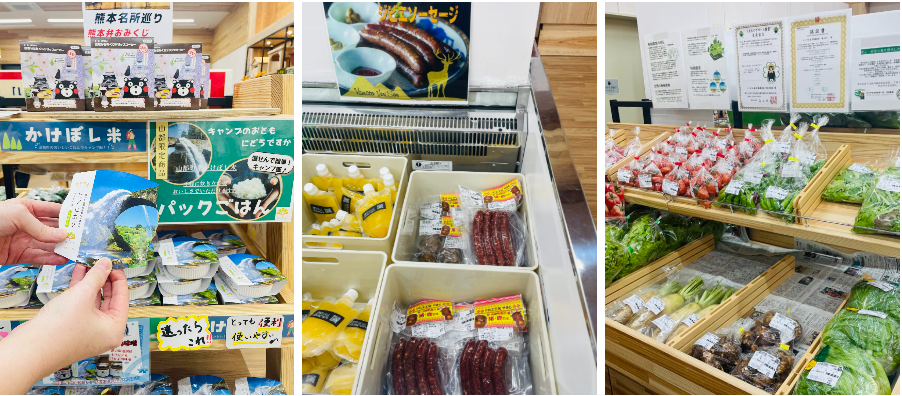

One thing that stood out to us as we explored was the focus on organic farming. Yamato Town has been ahead of its time in promoting sustainable agriculture since the 1970s, encouraging farmers to go organic long before it entered the mainstream. Inspired by this ethos, we stocked up on a selection of fresh, organic vegetables, locally grown rice, and game meat delicacies for a homemade feast that evening. Here’s what we got:

- Local organic vegetables: Including unique finds like micro-cucumbers, chayote (known as hayato-uri in Japanese), and vibrant microgreens.
- Game meat products: Ready-to-cook hamburg steaks made from locally caught wild boar, and sausages crafted from venison. We also grabbed some fresh eggs from the Soyo District to complete our breakfast plans.
- Steamed rice and more: Microwavable steamed rice made with 100% Yamato-grown rice—perfect for travelers. For those planning to cook, there’s a variety of rice available in different quantities. We also picked up yakigome (roasted, flattened rice), a traditional local food that can be eaten like oatmeal.
- Seasonings: Some soy sauce and locally-made salad dressing.
With our haul of fresh ingredients and local treasures, we were ready to head deeper into Yamato Town, excited to see what else the day had in store.
10:30 am—Gorogataki, A Waterfall to Remember

Standing an impressive 50 meters tall, Gorogataki (五老ヶ滝) is the largest waterfall in Yamato Town and a must-visit for nature lovers. Its name is said to come from the phrase “Goran no Taki,” or “The Waterfall You (Honorably) Look Upon,” a nod to the local tradition of showcasing its splendor to imperial envoys. And it’s no wonder—this natural wonder truly lives up to its name.
Reaching the base of the falls requires descending a steep path, but the payoff is spectacular. From the viewing platform, you can gaze up at the cascading water in its full glory. The sheer volume of water is powerful and commanding, yet there’s something mesmerizingly delicate about the white wisps of mist as they drift through the air.
For those who prefer a broader perspective, a convenient suspension bridge offers a perfect vantage point. Framed by lush greenery, the view of the falls is particularly magical in mid-November when the leaves turn vibrant shades of red and gold.

One detail that struck us was the rich moss clinging to the cliffs beside the falls. Thick, vibrant, and almost otherworldly in its lushness, it felt like it had been growing undisturbed for centuries. Even from a distance, the moss’s deep green hue was unmistakable.
After soaking in the beauty of Gorogataki, we made the climb back up—no small feat, but a great way to work up an appetite for lunch. Whether you’re seeking tranquility or a touch of adventure, this waterfall offers a memorable glimpse into the natural wonders of Yamato Town. It’s a place where history, beauty, and serenity flow together seamlessly.
11:30 am—Yamato Tourism & Cultural Exchange Center (Yamato Bunka no Mori): A Glimpse into Yamato’s Cultural Heart

After marveling at the power and beauty of Gorogataki, we decided to squeeze in one more stop before lunch: Yamato Tourism & Cultural Exchange Center (やまと文化の森, Yamato Bunka no Mori). Established in 2017, this center serves as both a hub for the community and a showcase of Yamato Town’s cultural heritage. It features rotating exhibitions, supports local industry, and even hosts outdoor events like concerts and markets, making it a vibrant space for locals and visitors alike.
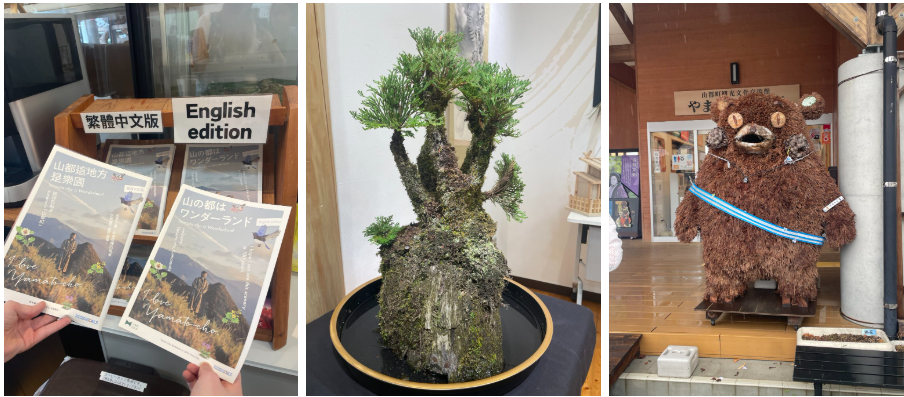
But the true highlight for us was the Otsukurimono (大造り物), the massive, intricate floats made entirely from natural materials such as pinecones, branches, and straw. These floats, lovingly crafted by locals, are paraded through the town during the Hassaku Festival in September, a tradition which continues from the Edo Period.
What’s remarkable about these floats is not just their sheer scale but the artistry and ingenuity behind them. Farmers, often during the off-season, have been creating these floats for generations, transforming simple, natural materials into works of art. Yamato Town’s dedication to this tradition speaks volumes about its strong sense of community and creative spirit.
If you’re interested in the Otsukurimono, Yamato Bunka no Mori is the perfect place to learn more and see some examples up close. You’ll also notice floats on display in multi-story workshops scattered throughout the area. These impressive structures are visible as you drive or walk through the town, adding an unexpected touch of wonder to the journey.
12:00 pm—Lunch Break at Café Kotonoha: A Taste of Nostalgia

For lunch, we decided to try Café Kotonoha, a charming café located conveniently next to one of Yamato Town’s main attractions, Tsujunkyo Bridge. Popular with locals for being a place to come and relax, enjoy a cup of coffee or tea, and even drinks after hours. We were also intruiged by the offering of the Showa-era Japanese dish, Napolitan spaghetti. While the concept of ketchup-based pasta might raise some eyebrows—especially from a Western or Italian perspective—this dish is a beloved staple in Japan. The ketchup is first fried, mellowing its sharp, vinegary tang and creating a flavor that’s rich, only slightly sweet, and satisfying. It was no wonder to me why Napolitan is a favorite among Japanese kids and adults alike.

The café also offers an affordable lunch set of curry, salad, and coffee or tea for just ¥900, making it a great spot for a filling meal. Whether you’re stopping by for a quick caffeine fix or a leisurely meal, the cozy, friendly atmosphere makes you feel right at home. We even heard it’s open late into the evening, offering everything from café staples to alcohol, making it a true community hub. They even have tapioca milk tea!
For those with different cravings, Yamato Town also boasts other noteworthy dining spots. Ochika Ramen, for example, serves up authentic Kumamoto-style ramen with thick slices of melt-in-your-mouth chashu in a rich, mellow broth. If you’re looking for something more refined, Tsujun Brewery offers a stunning lunch and sake tasting experience in its renovated kura (traditional sake warehouse) dating back to 1792, Kanseigura.
1:00 pm—Tsujunkyo Bridge

After lunch, we made our way to Tsujunkyo Bridge (通潤橋), one of Yamato Town’s most celebrated landmarks and now officially a National Treasure of Japan. Built in 1854 by regional headman Yasunosuke Futa, this incredible stone arch aqueduct vastly expanded the town’s rice production by diverting water to a dry plateau. Admiring the stonework, it was also interesting to reflect on the fact that this was constructed 14 years before Japan’s modern industrial boom during the Meiji Restoration. Futa’s contribution to the community was so profound that he’s still celebrated today—you can even visit a shrine dedicated to him nearby.
It’s not just the bridge itself, apparently the whole system stretches an impressive 30 kilometers, redirecting water from another river to irrigate the terraced rice fields—and still fully functional today.
Although there are many aqueducts in the ancient and modern world, what’s truly unique about Tsujunkyo Bridge is its ability to periodically release water in a brief display called “hosui” (放水). Originally designed to flush silt out of the aqueduct, it’s now a mesmerizing spectacle that draws visitors from all over. While watching, I wondered if the designers were inspired by Gorogataki Falls.
If you visit, you can admire Tsujunkyo Bridge from multiple angles—up close from the base or even on top of the bridge itself. There’s also a small museum nearby where you can learn about the bridge’s history and its role in the area’s development. But honestly, just being there in person, surrounded by its grand presence and the lush natural scenery, was enough to leave me deeply impressed. It’s not just a bridge—it’s a testament to the power of collective effort and ingenuity of this, at first glance, small rural community.
1:30 pm—ARBOL Ice Cream / Appartement: A Sweet and Sustainable Break
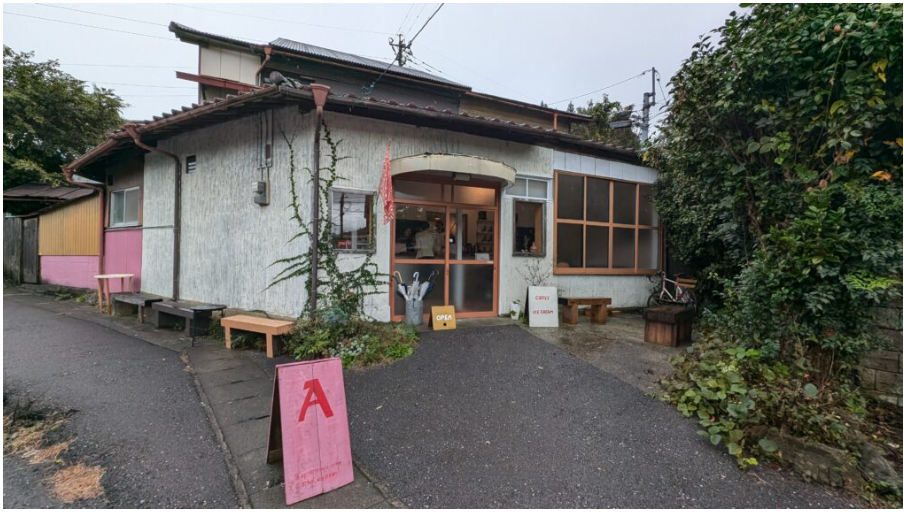
After exploring Tsujunkyo Bridge, we decided to recharge with something sweet—and ARBOL ICECREAM and Appartement turned out to be the perfect spot. Located in an old, repurposed house, this cozy café offers a unique combination of vegan ice cream and specialty coffee, making it an ideal place to relax and refuel.
ARBOL ICECREAM is all about sustainability and local pride. Their ice cream is 100% handmade using fruits and vegetables sourced from the area, and it’s completely free of dairy, white sugar, and gluten. We tried some truly creative flavors that pushed our taste buds in delightful new directions including the strawberry, roselle, and orange ice cream, the green hojicha and cacao nib ice cream, and the blueberry and sudachi ice cream.

What makes this spot even more special is its shared space with Appartement, a specialty coffee shop. Together, these two businesses create a warm, welcoming atmosphere where you can enjoy an expertly brewed single-origin Japanese drip coffee alongside your ice cream. After a morning of walking around town, we sank into a sofa and let the tatami mats and rustic décor work their relaxing magic.
2:00 pm—Kanseigura: A Historic Sake Experience with Modern Comfort

Our next stop was Kanseigura (寛政蔵), a café and shop nestled within the grounds of Tsujun Brewery (通潤酒造)—the oldest sake brewery in Kumamoto, established all the way back in 1792. The carefully curated interior, with its elegant tables and chairs, preserves the heritage of the space while adding a touch of modern refinement.

Kanseigura offers a tasting set featuring three varieties of their brewery-selected sake. For anyone curious about Japanese sake, this is a perfect opportunity to sample different flavors and learn about the brewing process in an inviting, relaxed setting (of course since I was comandeering the Kumamon rentacar, I didn’t partake). And for international visitors, the staff and menus are well-prepared with English support, reflecting their experience hosting travelers from Taiwan, Hong Kong, South Korea, and beyond. While the sake was a clear highlight, Kanseigura also serves as a cozy café offering delicious meals, and light desserts.
If you’re interested in diving deeper into the sake-making process, you can even catch a glimpse of the production area, offering a behind-the-scenes look at how the sake is made.

We couldn’t resist exploring the gift shop, which showcases an impressive range of products, from premium sake made with varying degrees of rice refinement to locally grown, pesticide-free organic rice. One standout was their plum wine, or umeshu. Unlike the typical versions made with distilled alcohol, this umeshu is crafted with undistilled sake, giving it a smooth, light flavor at just 11% alcohol. The bottle design—complete with a nod to Crayon Shinchan’s mom—was so charming we couldn’t resist grabbing one for dinner, along with a bottle of sake.

3:00 pm—Villa Yamato: A Cozy Lodge with a Touch of Japanese History

After a day packed with sightseeing in Yamato Town’s Yabe District, we were ready to unwind and decided to check into Villa Yamato (山都茶寮) a little early. This beautifully renovated traditional Japanese house is available as an exclusive-use lodging, making it perfect for group stays, family getaways, or anyone seeking a serene escape. The villa’s charming mix of modern convenience and historical character made it an unforgettable part of our trip.

The first thing that caught our attention was the villa’s impressive kitchen, a rare find in accommodations in Japan. It’s spacious, fully equipped, and clearly a holdover from the building’s former life as a restaurant. For foodies like us, who love experimenting with fresh, local ingredients, this kitchen was a dream. We couldn’t wait to cook up the produce and game meat we’d picked up earlier in the day.
Goemonburo

One of Villa Yamato’s unique features is its goemonburo (五右衛門風呂), a traditional wood-fired cast iron bathtub straight out of a Ghibli movie. The bath water takes about two hours to heat up, and when the water is ready, you carefully step onto a small circular wooden board, lowering it down with your feet to the bottom of the iron cauldron, so as to avoid getting burned. It’s a slice of Japanese history and an absolute treat, especially in the winter, when the sides of the bath stay warm and cozy. If you’ve already experienced an onsen or sento, the goemonburo offers an entirely different bathing experience.

Inside and outside the villa, you’ll find other small, quirky details that hint at its past, like graffiti left by carpenters dating back to the 1950s when the villa was built, and winding rural roads. It’s these little touches that make the space feel so authentic and full of character. It’s also near Seiwa Kogen Observatory (清和高原天文台) if you want to take a look at the night sky (the view from the lodge is also great). The host is wonderfully hands-off—after a quick orientation and scheduling your bath time, you’re left to enjoy the place at your own pace.
Dinner and Breakfast Fit for a Hunter’s Lodge

For dinner, we cooked up the wild boar hamburger steaks we’d bought earlier, pairing them with stir-fried local vegetables and perfectly fluffy Yamato rice. We decided to stir fry the chayote with some of the farm-fresh eggs, which went well with the rice.
The next morning, we were up early to prepare venison sausages with fried eggs—simple but so satisfying. If you’re staying longer or want to try other game meats, the Gibier Kobo Yamato (ジビエ工房やまと), the town’s game meat butcher shop, offers a great selection of local cuts when open.

Villa Yamato gave us the perfect mix of relaxation and cultural immersion. Between the historic ambiance, the incredible kitchen, and the unique bath experience, it’s a place we’d recommend to anyone looking to slow down and truly connect with the charm of Yamato Town.
Day 2
9:00 am—Soyo Gorge: The Grand Canyon of Kyushu

After a hearty breakfast of venison sausages, we checked out of Villa Yamato, hopped back into our Kumamon Rent-a-Car, and set off to breathe in some crisp mountain air. Our destination was the Soyo Gorge (蘇陽峡), a place that locals have dubbed the “Grand Canyon of Kyushu.” The canyon was created by the combined actions of both the repeated pyroclastic flows from Mt. Aso, and the eroding action of the river, over hundreds of thousands of years.
Perched between mountains of the central Kyushu mountain range, the gorge offers panoramic views that make you feel as though you’re standing atop the island itself. From the Nagasakibana Observation Deck (長崎鼻展望台), we gazed out over a pristine, U-shaped valley carved by the Gokase River, with steep 200-meter cliffs stretching for 10 kilometers, and saw quite clearly the five peaks of Mount Aso in the distance.
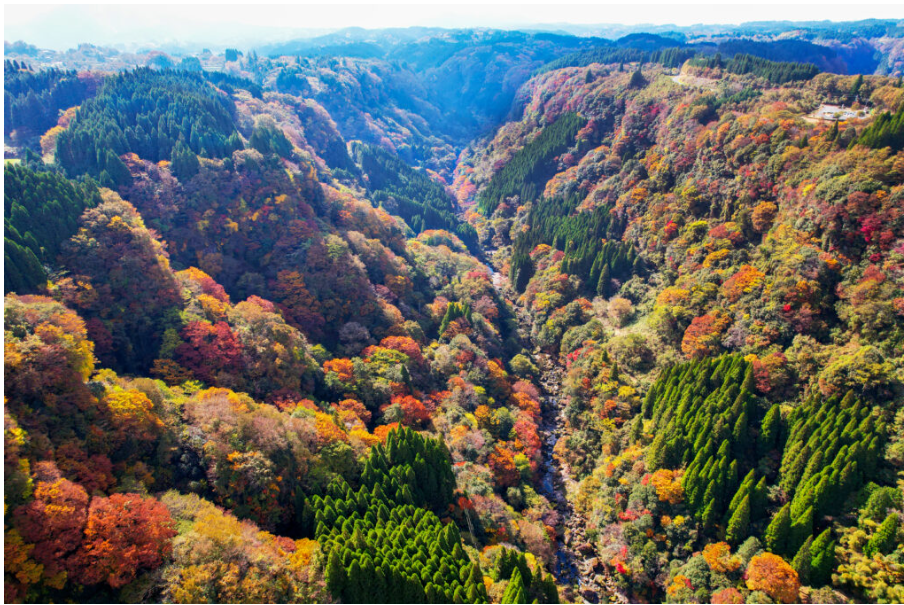
Visiting in early November, we were treated to some promising initial signs of autumn colors, but visiting a bit later in the season can ensure a more breathtaking display of reds, oranges, and yellows.
10:00 am—Heitate Shrine: Where Legends and Nature Converge
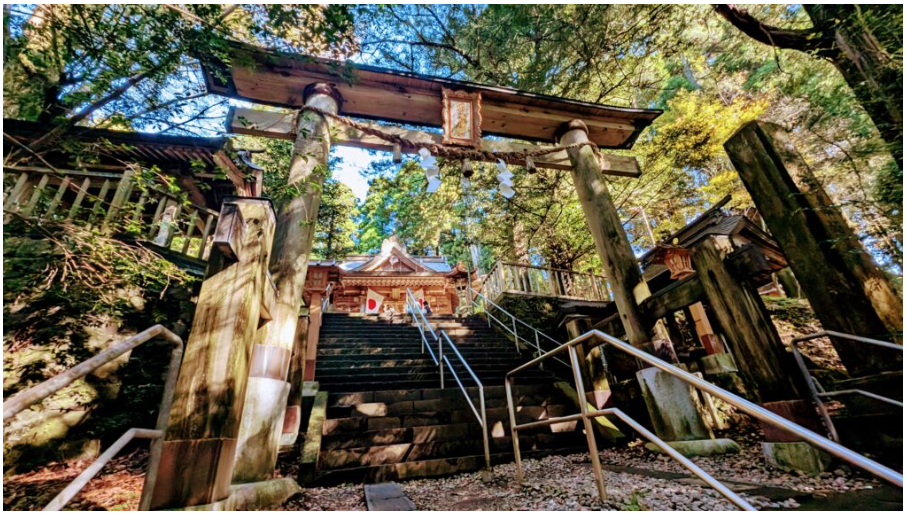
Our next stop was Heitate Shrine (幣立神社), a site shrouded in legend and surrounded by the natural beauty of Yamato Town. The grounds where this shrine stands have been regarded as sacred for centuries, with the local community continuing to honor and care for it to this day. While some of its historical claims, such as a 15,000-year legacy or its ties to the first Chinese emperor, might seem exaggerated, there’s no denying the sense of reverence and history that permeates the place.

A pathway descending downhill from the back of the shrine leads to another shrine and highly mysterious looking pond. A sign explains the site as the home of the Eight Dragon Kings, and ties these waters to Qin Shi Huang, the first emperor of China, who supposedly sought them in his quest for immortality. While the stories are intriguing, what truly captivated us was the quiet serenity of the scene—the kind that invites you to pause and simply take it all in.
11:00 am—Mamihara Historical District
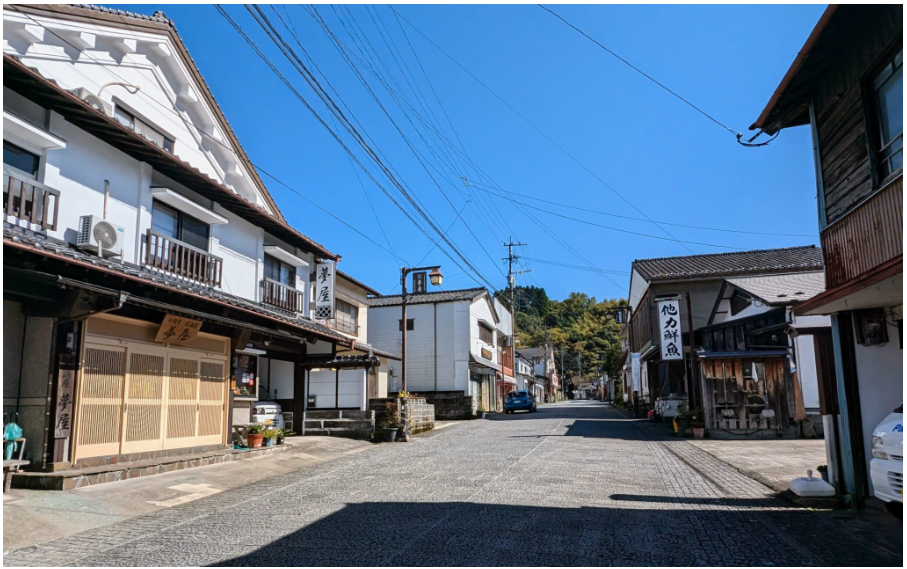
After exploring the shrine, we decided to take a walk through the nearby Mamihara Shopping Street (馬見原商店街), beautifully preserved area with stone-paved paths, wooden facades, thriving local businesses and a nostalgic atmosphere made it easy to imagine what life might have been like here generations ago. What struck us first, though, was the bridge leading into the town. It has two levels—one for cars and one below for pedestrians—with breathtaking views of the calm, crystal-clear river that flows along the edge of the town. It was the perfect introduction to Mamihara’s peaceful charm.
Coffee and Donuts at Jugaad Bros Donuts

We started our exploration with a visit to Jugaad Bros Donuts, a cozy and colorful shop run by a couple with a passion for travel and global flavors. Their Tunisian bambalouni donuts, fried fresh to order, were a standout—crispy on the outside and airy on the inside. They also offer vegan-friendly options and classic old-fashioned donuts, making it hard to pick just one. We paired our donuts with coffee and ended up chatting with a group of young travelers from Europe staying at the nearby Omusubi Guesthouse, a renovated Japanese-style inn that provides a welcoming base for travelers. Hearing about their adventures led us to discover that Mamihara isn’t just a historical site—it’s in fact slowly becoming a hub for those looking to experience authentic Kyushu.
Niku no Miyabe: A Legacy of Local Meat

Next, we stopped by Niku no Miyabe (肉のみやべ), a historic butcher shop that’s been part of the community since 1926. Famous for its Sakura Korokke, a deep-fried croquette of mashed potatoes and horse meat, the shop prides itself on its high quality of its beef and horse meat, many cuts of which can be eaten raw as sashimi. One thing that stood out to us was their hospitality. The friendly staff even offered to fry up anything from the display counter—like seasoned chicken—on-site. They mentioned that many visitors from the guesthouse next door stop in to grab fresh meat to cook themselves or picnic on prepared food by the river. Local campers, too, often pop in for barbecue supplies. We opted for a Sakura Croquette to-go and loved every bite—it was crispy, flavorful, and the perfect snack for our walk through town.
Tariki Sengyo: A Local Favorite for Seafood

Complementing the meat shop, the town is also home to a fishmonger—Tariki Sengyo (他力鮮魚). A third-generation family-run business, it not only supplies local izakaya with fresh fish, it also offers local families everything from fresh sashimi to fried fish dishes, made with care and quality you can taste. No matter how deep in the mountains you are in Japan, I suppose people still enjoy eating fresh fish! Tariki Sengyo seem to have no issues with keeping the catch fresh with their massive outdoor fish tank, which is replenished weekly with deliveries from Tasaki Market in Kumamoto City. One dish that caught my eye was their gyorokke (a croquette made with fish) and hoki furai (crispy fried fish fillets) for just 150 yen each, which are also perfect for a quick bite or a picnic by the river.
A Blend of Tradition and Innovation

What struck us most about Mamihara was its seamless blend of history and modern creativity. The streetscape retains its Edo-period layout, complete with remnants of its role as a strategic checkpoint between fuedal domain boundaries, and is even home to an award-winning tea plantation. At the same time, innovative businesses like Jugaad Bros Donuts and the Omusubi Guesthouse breathe new life into the area, creating a dynamic balance between past and present.
Mamihara is a quiet but captivating destination—a place where you can slow down, savor local flavors, and connect with the layers of history and life that make this corner of Yamato Town so special.
13:30—Seiwa Bunraku Village: Puppet Theatre Rooted in Local Tradition

The final stop on our itinerary was Seiwa Bunraku Village (清和文楽邑). Nestled into the mountainside along Route 218, the main road bisecting Yamato, its a facility that combines the functions of town square, museum, farmer’s market and yet it’s main raison d’être is as a venue for Bunraku puppet theater. The venue celebrates this rare art form, brought to the region by a traveling troupe in the 19th century and lovingly adapted by local farmers as a communal pastime.
A Glimpse into the World of Bunraku
Even if you can’t catch a live performance, the interactive exhibits at Seiwa Bunraku Theater are well worth exploring. They guide you through the history, techniques, and cultural significance of Bunraku as it evolved in this rural corner of Kumamoto. The facility itself is striking—a harmonious mix of modern design and traditional Japanese architecture, blending seamlessly with its picturesque surroundings. The theater serves not just as a stage but also as a community gathering place, hosting festivals, outdoor performances. On the day we visited, the energy was lively, with families and locals enjoying the space as much as the art.
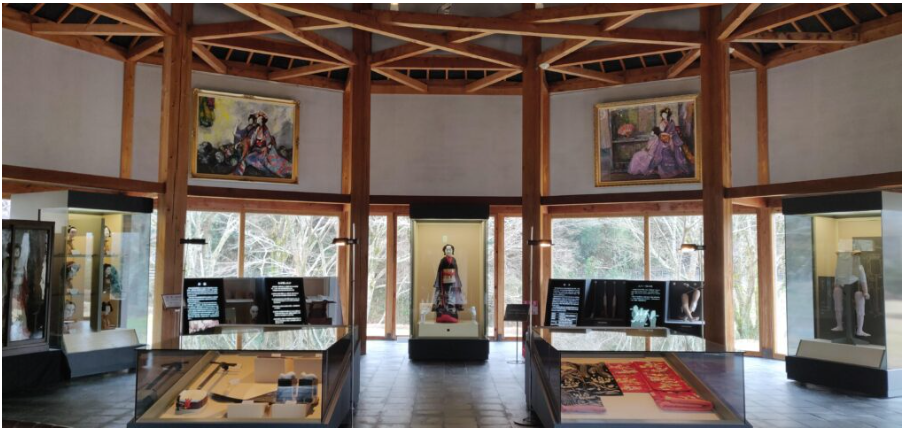
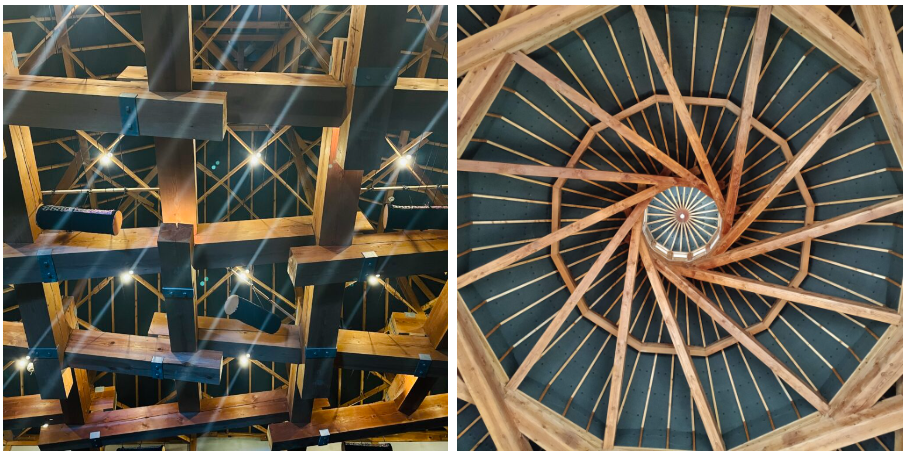
Live Performances and Accessibility
For those lucky enough to catch a show, Seiwa Bunraku offers a captivating display of puppetry, narration, and shamisen music. While traditional Japanese performing arts can sometimes feel intimidating or “high-brow,” this theater goes out of its way to make the art form accessible. Pamphlets with detailed plot explanations are available in English, ensuring non-Japanese speakers can follow along. And the interactive “Fureai Time” lets visitors handle the puppets.

A particularly exciting announcement during our visit was the resumption of the One Piece Seiwa Bunraku collaboration, set to begin performances in January 2025. The show began in 2024, as part of the same “ONE PIECE Kumamoto Revival Project” that saw statues of various One Piece characters placed around Kumamoto in the aftermath of the 2016 Earthquakes. Reservations are already open, and it’s sure to bring a fresh audience to this tradition.
A Creative Outlet for Farmers
One of the most inspiring aspects of Seiwa Bunraku is its origins. In the mid-19th century, local farmers, inspired by visiting performers, turned Bunraku into their creative outlet during downtime. While some samurai are often celebrated for their dual mastery of culture and the sword (bunbu ryōdō), I think the farmers of Yamato demonstrate their own balance—wielding both the sickle and the arts. Seiwa Bunraku’s puppets are known for their larger, more expressive movements, a nod to the outdoor stages they were traditionally performed on, where visibility was key.
A Legacy Preserved
Today, Seiwa Bunraku thrives as both a local treasure and an internationally recognized art form, with past performances in Ireland, Italy, and South Korea. The theater continues to honor this legacy with over 200 performances annually and engaging exhibits for those visiting outside showtimes. Whether you’re drawn to its historical significance or just curious about traditional Japanese arts, Seiwa Bunraku offers a window into the creativity and resilience of rural Japan.
Seiwa Bunraku Village reminded us that art isn’t just something reserved for elite urban spaces—it’s a living, breathing part of community life. And here in Yamato, it continues to inspire and connect people from all walks of life.
Lunch Options Near Seiwa Bunraku
If you’re visiting Seiwa Bunraku Village around lunchtime, you’ll be glad to know there are several excellent dining options nearby.
One convenient choice is the cafeteria located in the local product hall (物産館 bussankan) building next to the theatre, open from 11:00 AM to 3:00 PM. Their extensive menu features local specialties such as dagojiru (a hearty dumpling soup) and mazemeshi (flavorful rice mixed with simmered vegetables). For international visitors, the menu is available in English and Chinese, making it easy to navigate.

Another great option is Soba Bunraku (そば文楽), a charming soba noodle restaurant just a five-minute walk (or a quick 30-second drive) from the theater. This cozy spot serves hand-made soba noodles alongside a variety of dishes, making it an ideal place to enjoy a satisfying lunch.
As for us, we were still happily full from the delicious treats we’d indulged in back at Mamihara, so we decided to give our stomachs a rest and save these spots for next time.
Wrapping Up: A Memorable Journey Through Yamato Town
After immersing ourselves in the beauty, culture, and flavors of Yamato Town, we hopped back into our Kumamon Rent-a-Car and made our way back to Kumamoto City, feeling refreshed and inspired. From the engineering marvel of Tsujunkyo Bridge to the enchanting puppetry at Seiwa Bunraku Village, this 1-night, 2-day trip gave us a deep appreciation for the history, creativity, and community spirit that define this corner of Kyushu.
Plan Your Trip to Yamato Town
If you’re inspired to explore Yamato Town, here’s a quick recap of some highlights from our itinerary and a Google Map with everything featured.
- Tsujunkyo Bridge: Stone arch aqueduct from the Edo period. Check the schedule here to see when the water flows!
- Gorogataki Waterfall: A breathtaking natural wonder and a great leg workout!
- Heitate Shrine: A place of legends, spirituality, and serene beauty.
- Mamihara Historical District: Step back in time while enjoying modern treats like donuts and croquettes.
- Seiwa Bunraku Village: Experience the charm of traditional Japanese puppetry with a local twist.
Helpful Links
- Kumamon Rent-a-Car: Booking Info (Book by calling Toyota Rentalease Kumamoto at +81 96-295-0100)
- Seiwa Bunraku Theater Schedule and Reservations: Visit the official site
- Countryside Stays Japan: Yamato Town Information: Explore more
Tips for Your Visit
- Driving: The Kyushu Chūō Expressway makes access to Yamato Town fast and easy, but having a navigation app is highly recommended for exploring rural areas. Rental cars, including the Kumamon Rent-a-Car we used included GPS built-in. In parts of our trip, roads could be quite narrow and steep, so please drive carefully!
- Seasonal Visits: Autumn offers extra charm with the autumn foliage, but its nice to visit Yamato in the summer too, since the heavy forest cover and high elevation make it noticeably cooler than other destinations in urban Japan at the same time.
- Local Food: Don’t miss the chance to try game meat specialties, organic vegetables, and the plethora of local businesses.
Whether you’re looking for history, nature, or simply a slower pace of life, Yamato Town is a destination that offers something for everyone, either in combination with neighbouring areas in Aso and Miyazaki, or simply Yamato alone. We hope this guide inspires your own adventure into the heart of Kyushu. Happy travels!







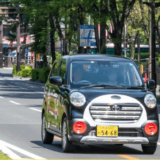


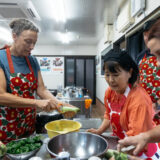





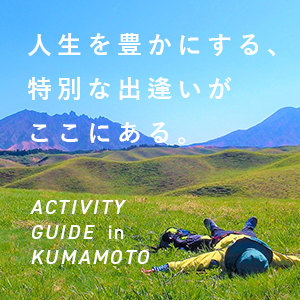














That’s one of the best travel experience pieces I’ve ever read. I’ve written a plethora myself, but I’ve never written an itinerary piece. But your piece makes Yamato sound like a can’t miss destination.
Thanks for your comment Mike! Hope it inspired you at least a little bit to visit Yamato Town someday. I’m interested to see what kinds of travel stuff you’ve written–if you have a chance definitely share a link! 🙂
[…] Tip: See our other article about renting a Kumamon Rent-a-Car for the ultimate Kyushu travel adventure! Whether you’re cruising through terraced rice fields or chasing mountain views, a rental car opens up more possibilities. […]